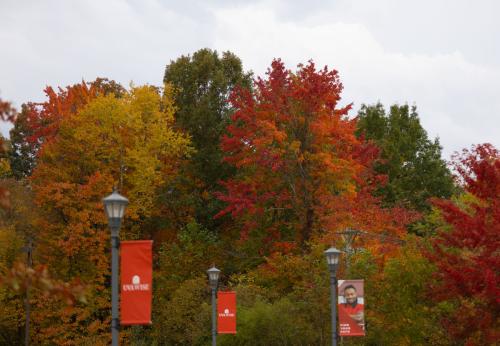It’s the season to fall for UVA Wise

October at the University of Virginia’s College at Wise brings longer and richer fall colors. UVA Wise Associate Professor of Biology Wally Smith credits the month-long fall color season to the range of high to lower elevations in and around the College’s home, Wise County.
“The great thing about our local area is that we have a prolonged fall color season here due to the dramatic variety in elevation throughout the county. Trees in higher elevations change first and then the colors move down in elevation as the season progresses,” Smith said.
UVA Wise’s area also boasts a diverse fall color palette. The local forests have a lush mixture of colors because of the high amount of tree diversity, Smith said.
Appalachian Mixed Mesophytic Forest, which is one of the most biodiverse forest types on the planet, covers much of Wise County. As many as 30 tree species can be found at a site. The higher elevations surrounding High Knob are also home to Northern Hardwood Forests, an ecosystem more typically found across portions of New England and characterized by sugar maples and birches.
“That diversity helps our local forests run the full spectrum of fall colors each season,” Smith said.
Maples, for example, will produce a mixture of reds, oranges and yellows, with some especially vivid colors from those species on the ridges across High Knob.
Beech and birch trees will exhibit radiant yellows. Oaks showcase spectacular red hues. But not all colorful leaves will fall.
Many beeches and oaks hold onto their leaves long after their color is gone, rather than dropping them quickly to the forest floor. This is a phenomenon called marcescence that occurs when certain trees delay shedding of their leaves (a process called abscission) until the forthcoming spring season, Smith said.
“Precisely why some trees do this is still a mystery—some hypotheses predict that it might protect stems from deer and other browsers who avoid eating difficult-to-digest dead leaves or help fertilize the soil when leaves fall at the start of the spring growing season,” Smith said. “These trees also help provide some extra texture and color to the forest late into the fall season and throughout the winter months, even after peak color is gone.”
Timing of the fall color season can vary from year-to-year due to weather conditions, but color begins to become vibrant across the high country (above 3,500 feet) such as the High Knob Tower area in early to mid-October, Smith said.
“So far, it’s looking like we’ll be having a solid color season this fall,” Smith said. “I imagine we’ll see color begin to move downward in elevation over the next couple of weeks.”
Middle elevations (between 2,500 and 3,500 feet), such as Flag Rock above Norton down to Wise, start to change in mid-to-late October. The lowest elevations (below 2,500 feet), such as the floor of Powell Valley, Big Stone Gap, St. Paul and Pound, come along soon after.
"This all means that folks in Wise County and those visiting our area have the ability to see peak fall colors for the better part of a solid month, if they travel around to various elevations that are peaking at a given time,” Smith said.
Smith shared his favorite color hot-spots for this time of year:
His favorite go-to spot is Flag Rock Overlook, near Norton, which has a wonderful vantage point. Pickem Mountain, the ridge to the right of the overlook hemmed in by cliffs, is a Maple-heavy ridgeline which often has some of the season’s most vibrant color, Smith said. The overlook provides great views of Norton and Wise, too.
Other wonderful color-spotting options include High Knob Tower, the Powell Valley Overlook, the Sugar Hill Loop at the Clinch River State Park and the Guest River Gorge Trail.
If you are searching for that perfect fall color drive, take a road trip along the floor of Powell Valley from Big Stone Gap.
“It’s a good option when the colors are peaking for folks who may not want to get ‘out there’ on a hike,” Smith said.
The College also offers great locales to soak in the fall colors including the David J. Prior Convocation Center.
Walking from the upper lot behind the Leonard W. Sandridge Science building along the gravel road to the observatory is another great location. From there, you can see a beautiful view of High Knob when the colors are peaking, Smith said.